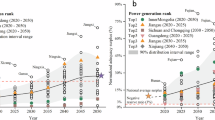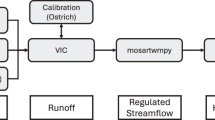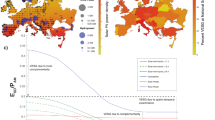Abstract
Carbon reduction goals have driven China to become the world’s largest renewable energy system (RES) that is dominated by hydropower, wind power and solar power. However, the meteorological sensitivity of wind and solar power greatly affects the reliability and generating capability of the RES, particularly in extreme weather events. Quantifying the electricity supply and flexibility of hydropower is crucial for compensating extreme wind and solar power generation. Here we investigate the influence of extreme weather combinations and future climate on the generating capability of the national RES and quantify the flexibility demand and hydropower supply in typical extreme weathers. Our analysis reveals that the annual utilization hours of the hydropower–wind–solar system are projected to decline by nearly 12% from the current stage to 2060 under conditions of extreme drought, low wind and weak solar radiation. When encountered with extremely strong solar radiation and wind, the probability of flexibility shortages in hydropower is estimated to rise to 47% by 2030 and further increase to 60% by 2060. Nearly half of the provinces will require tens of millions of kilowatts of energy storage by 2030 to supplement the flexibility supply gap of hydropower, and by 2060, both the number of provinces that require such a large-scale energy storage and the storage capacity needs might double. Our findings provide early warnings in extreme electricity supply and underscore the growing necessity for building dispatchable power plants and exploring the flexibility of existing hydropower systems.
This is a preview of subscription content, access via your institution
Access options
Subscribe to this journal
Receive 12 digital issues and online access to articles
$119.00 per year
only $9.92 per issue
Buy this article
- Purchase on SpringerLink
- Instant access to full article PDF
Prices may be subject to local taxes which are calculated during checkout







Similar content being viewed by others
Data availability
ERA5 data are available at https://www.ecmwf.int/. CMIP6 data are available at https://aims2.llnl.gov/search. The operating parameters and run-off data for reservoirs and hourly load cannot be disclosed owing to our non-disclosure agreements with power grid corporations. However, they can be obtained from the corresponding author upon reasonable request. Other data used in this Article are provided in the Supplementary Information (Supplementary Tables 8–18).
Code availability
The optimal scheduling model for hydropower is solved by Lingo 18. The interprovincial power exchange model, 8,760 h production simulation and energy storage sizing optimization model are implemented via Python 3.10 and solved by Gurobi 10.0.1. The evaluation method for flexibility demand and supply is implemented via MATLAB R2018a. All the core codes are in the Supplementary Information. Other codes can be obtained from the authors upon reasonable request.
References
Liu, Z. & He, X. Balancing-oriented hydropower operation makes the clean energy transition more affordable and simultaneously boosts water security. Nat. Water 1, 778–789 (2023).
Barrett, J. et al. Energy demand reduction options for meeting national zero-emission targets in the United Kingdom. Nat. Energy 7, 726–735 (2022).
Sterl, S. et al. Smart renewable electricity portfolios in West Africa. Nat. Sustain. 3, 710–719 (2020).
Mengke, L. et al. Long-term multi-objective optimal scheduling for large cascaded hydro-wind-photovoltaic complementary systems considering short-term peak-shaving demands. Energy Convers. Manag. 301, 118063 (2024).
Xi, J. Statement at the general debate of the 76th session of the United Nations General Assembly. United Nations, https://www.gov.cn/xinwen/2021-09/22/content_5638596.htm (2021).
Wang, Y. et al. Accelerating the energy transition towards photovoltaic and wind in China. Nature 619, 761–767 (2023).
Yang, X. et al. Breaking the hard-to-abate bottleneck in China’s path to carbon neutrality with clean hydrogen. Nat. Energy 7, 955–965 (2022).
Statistical Data of the National Power Industry in 2023 (National Energy Administration, 2024); https://www.nea.gov.cn/2024-01/26/c_1310762246.htm
Research on China’s 2030 Energy and Electricity Development Plan and Outlook for 2060 (Global Energy Interconnection Development and Cooperation Organization, 2021); http://www.chinapower.com.cn/tynfd/zcdt/20210320/59388.html
Liu, L. et al. Climate change impacts on planned supply–demand match in global wind and solar energy systems. Nat. Energy 8, 870–880 (2023).
Martinez, A. & Iglesias, G. Global wind energy resources decline under climate change. Energy 288, 129765 (2024).
Pryor, S. C. et al. Climate change impacts on wind power generation. Nat. Rev. Earth Environ. 1, 627–643 (2020).
Heptonstall, P. J. & Gross, R. J. K. A systematic review of the costs and impacts of integrating variable renewables into power grids. Nat. Energy 6, 72–83 (2021).
Northeast China, Making Every Effort to Ensure the Safety of the Power Grid (Northeast Branch of State Grid Corporation of China, 2021); http://www.ne.sgcc.com.cn/dbdwww/zxzx/mtjj/202111/t20211112_55676.htm
Why Is Sichuan, a Major Hydropower Province, Facing Power Shortages? (People’s Government of Sichuan Province, 2022); https://www.sc.gov.cn/10462/10464/13722/2022/8/18/a041da76a6cd45b79b9f39d89b06187d.shtml
Getirana, A., Libonati, R. & Cataldi, M. Brazil is in water crisis—it needs a drought plan. Nature 600, 218–220 (2021).
System Event Report South Australia, 8 February 2017 (Australia Energy Market Operator, 2017); http://pfbach.dk/firma_pfb/references/aemo_system_event_report_SA_8_feb_2017.pdf
Busby, J. W. et al. Cascading risks: Understanding the 2021 winter blackout in Texas. Energy Research & Social Science 77, 102106 (2021).
Preliminary Root Cause Analysis Mid-August 2020 Heat Storm (California ISO, 2020)
Jeffrey, A. et al. Extending energy system modelling to include extreme weather risks and application to hurricane events in Puerto Rico. Nat. Energy 6, 240–249 (2021).
Panteli, M. & Mancarella, P. Influence of extreme weather and climate change on the resilience of power systems: Impacts and possible mitigation strategies. Electr. Power Syst. Res. 127, 259–270 (2015).
van der Most, L. et al. Extreme events in the European renewable power system: validation of a modeling framework to estimate renewable electricity production and demand from meteorological data. Renew. Sustain. Energy Rev. 170, 112987 (2022).
van der Wiel, K. et al. Meteorological conditions leading to extreme low variable renewable energy production and extreme high energy shortfall. Renew. Sustain. Energy Rev. 111, 261–275 (2019).
Perera, A. T. D. et al. Quantifying the impacts of climate change and extreme climate events on energy systems. Nat. Energy 5, 150–159 (2020).
Höltinger, S. et al. The impact of climatic extreme events on the feasibility of fully renewable power systems: a case study for Sweden. Energy 178, 695–713 (2019).
Nik, V. M. Making energy simulation easier for future climate—synthesizing typical and extreme weather data sets out of regional climate models (RCMs). Appl. Energy 177, 204–226 (2016).
Zhang, Y. et al. Assessment of climate change impacts on the hydro-wind-solar energy supply system. Renew. Sustain. Energy Rev. 162, 112480 (2022).
Gonzalez, J. M. et al. Designing diversified renewable energy systems to balance multisector performance. Nat. Sustain. 6, 415–427 (2023).
Shen, J. et al. Pumped-storage renovation for grid-scale, long-duration energy storage. Nat. Rev. Electr. Eng. 2, 79–80 (2025).
Guerra, O. J. Beyond short-duration energy storage. Nat. Energy 6, 460–461 (2021).
China Electric Power Statistical Yearbook 2020 (China Electricity Council, 2020)
Acknowledgements
This work was supported by the National Natural Science Foundation of China (grant nos. U23A20667, 52239001 and 52079014).
Author information
Authors and Affiliations
Contributions
J.S., Y.W. and M.L. designed and performed the experiments. J.S. and Y.W. analysed the data and wrote the paper. C.C., J.K.K., J.W., X.G., X.L., B.Z. and L.G. reviewed and edited the paper.
Corresponding author
Ethics declarations
Competing interests
The authors declare no competing interests.
Peer review
Peer review information
Nature Water thanks Omar J. Guerra and Amarasinghage Tharindu Perera for their contribution to the peer review of this work.
Additional information
Publisher’s note Springer Nature remains neutral with regard to jurisdictional claims in published maps and institutional affiliations.
Supplementary information
Supplementary Information
Supplementary Notes 1 and 2, Figs. 1–14 and Tables 1–18.
Supplementary Code 1
Interprovincial power exchange model.
Supplementary Code 2
8,760 h production simulation.
Supplementary Code 3
Energy storage sizing optimization model.
Source data
Source Data Fig. 1
China map; selected eight basin boundaries; provincial wind power density at 100 m and the total solar radiation.
Source Data Fig. 2
The experience frequency of inflows from 1980 to 2019 for selected eight basins; the national wind capacity factors and the number of provinces included in each level from 1980 to 2019; the national solar capacity factors and the number of provinces included in each level from 1980 to 2019.
Source Data Fig. 3
The generating capability of hydropower in 2023; the generating capabilities of wind and solar power in extremely strong and weak scenario in 2023; the generating capabilities of hybrid system under different scenarios in 2023; the generating capabilities of scenario 1 in 2023, 2030 and 2060.
Source Data Fig. 4
China map; provincial power shortage and curtailment of July in scenario 1 in 2023, 2030 and 2060 under two modes: independent operation of provincial power grids and considering the interprovincial channels.
Source Data Fig. 5
UFD and DFD under different scenarios in the current stage.
Source Data Fig. 6
The IPUPF and IPDFP under different scenarios in the current stage; the share of hydropower in total installed capacity.
Source Data Fig. 7
Power capacities of energy storage under scenario 1 in 2030 and 2060; the IPUFP and IPDFP under scenario 1 in 2030 and 2060.
Rights and permissions
Springer Nature or its licensor (e.g. a society or other partner) holds exclusive rights to this article under a publishing agreement with the author(s) or other rightsholder(s); author self-archiving of the accepted manuscript version of this article is solely governed by the terms of such publishing agreement and applicable law.
About this article
Cite this article
Shen, J., Wang, Y., Lin, M. et al. Quantifying the impact of extreme weather on China’s hydropower–wind–solar renewable energy system. Nat Water 3, 415–429 (2025). https://doi.org/10.1038/s44221-025-00408-9
Received:
Accepted:
Published:
Issue date:
DOI: https://doi.org/10.1038/s44221-025-00408-9



